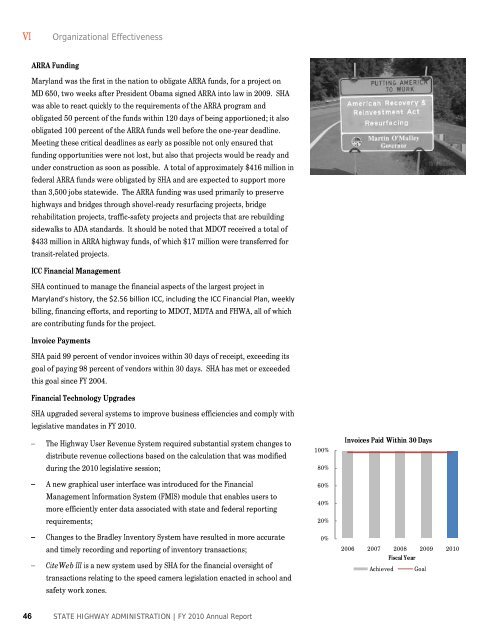2010 Annual Report - Maryland State Highway Administration
2010 Annual Report - Maryland State Highway Administration
2010 Annual Report - Maryland State Highway Administration
You also want an ePaper? Increase the reach of your titles
YUMPU automatically turns print PDFs into web optimized ePapers that Google loves.
VI<br />
Organizational Effectiveness<br />
ARRA Funding<br />
<strong>Maryland</strong> was the first in the nation to obligate ARRA funds, for a project on<br />
MD 650, two weeks after President Obama signed ARRA into law in 2009. SHA<br />
was able to react quickly to the requirements of the ARRA program and<br />
obligated 50 percent of the funds within 120 days of being apportioned; it also<br />
obligated 100 percent of the ARRA funds well before the one-year deadline.<br />
Meeting these critical deadlines as early as possible not only ensured that<br />
funding opportunities were not lost, but also that projects would be ready and<br />
under construction as soon as possible. A total of approximately $416 million in<br />
federal ARRA funds were obligated by SHA and are expected to support more<br />
than 3,500 jobs statewide. The ARRA funding was used primarily to preserve<br />
highways and bridges through shovel-ready resurfacing projects, bridge<br />
rehabilitation projects, traffic-safety projects and projects that are rebuilding<br />
sidewalks to ADA standards. It should be noted that MDOT received a total of<br />
$433 million in ARRA highway funds, of which $17 million were transferred for<br />
transit-related projects.<br />
ICC Financial Management<br />
SHA continued to manage the financial aspects of the largest project in<br />
<strong>Maryland</strong>’s history, the $2.56 billion ICC, including the ICC Financial Plan, weekly<br />
billing, financing efforts, and reporting to MDOT, MDTA and FHWA, all of which<br />
are contributing funds for the project.<br />
Invoice Payments<br />
SHA paid 99 percent of vendor invoices within 30 days of receipt, exceeding its<br />
goal of paying 98 percent of vendors within 30 days. SHA has met or exceeded<br />
this goal since FY 2004.<br />
Financial Technology Upgrades<br />
SHA upgraded several systems to improve business efficiencies and comply with<br />
legislative mandates in FY <strong>2010</strong>.<br />
The <strong>Highway</strong> User Revenue System required substantial system changes to<br />
distribute revenue collections based on the calculation that was modified<br />
during the <strong>2010</strong> legislative session;<br />
A new graphical user interface was introduced for the Financial<br />
Management Information System (FMIS) module that enables users to<br />
more efficiently enter data associated with state and federal reporting<br />
requirements;<br />
Changes to the Bradley Inventory System have resulted in more accurate<br />
and timely recording and reporting of inventory transactions;<br />
CiteWeb III is a new system used by SHA for the financial oversight of<br />
transactions relating to the speed camera legislation enacted in school and<br />
safety work zones.<br />
100%<br />
80%<br />
60%<br />
40%<br />
20%<br />
0%<br />
Invoices Paid Within 30 Days<br />
2006 2007 2008 2009 <strong>2010</strong><br />
Fiscal Year<br />
Achieved<br />
Goal<br />
46<br />
STATE HIGHWAY ADMINISTRATION | FY <strong>2010</strong> <strong>Annual</strong> <strong>Report</strong>
















